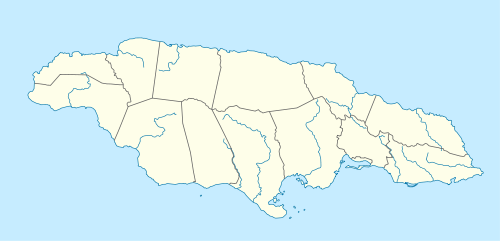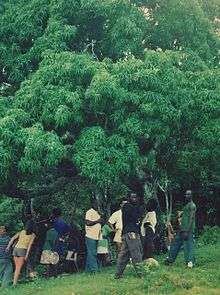Accompong
Coordinates: 18°14′N 77°45′W / 18.233°N 77.750°W
| Accompong | |
|---|---|
.jpg) Accompong, Jamaica, early 20th century | |
| Nickname(s): Acheampong | |
 Accompong | |
| Coordinates: 18°14′N 77°45′W / 18.233°N 77.750°W | |
| Country |
|
| Parish | St. Elizabeth Parish |
Accompong (from the Akan name Acheampong) is a historical Maroon village located in the hills of St. Elizabeth Parish on the island of Jamaica. It is located in Cockpit Country, where the local terrain enabled Jamaican Maroons and indigenous Taíno to establish a fortified stronghold in the 17th century. They defended it to maintain independence from the Spanish and then later against British forces, after the colony changed hands.
The people named their community Accompong after an early Maroon leader. Their autonomy with certain rights for limited self-government was established by a peace treaty with the British in 1739.[1] Since independence in 1962, the government of Jamaica has continued to recognize Maroon indigenous rights in this area.
History
In the 18th century, Maroon leader Cudjoe[2] is said to have united his people under the Kindah Tree in their fight for autonomy. This was the site for signing the 1739 treaty with the British. This legendary, ancient mango tree is still standing (2009).[3] The tree symbolizes the common kinship of the community on its common land.[4]

Accompong probably came into existence in the 1730s, during the First Maroon War, when rebel slaves and their descendants fought a guerrilla war against the British that was finally settled by a treaty between the two groups in 1739. The treaty signed under British governor Edward Trelawny granted Cudjoe’s Maroons 1500 acres of land between their strongholds of Cudjoe's Town (Trelawny Town) and Accompong in the Cockpits. However, while the treaty granted this land to Trelawny Town, it did not recognize the existence of Accompong Town. In 1756, following a land dispute between Maroons from Accompong Town and neighbouring planters, the Assembly granted Accompong Town an additional 1,000 acres of land.[5]
The treaty also granted a certain amount of political autonomy and economic freedoms for the Maroons, in return for which they were obligated to provide military support in case of invasion or rebellion, and to return runaway slaves in exchange for a bounty of two dollars each. This last clause in the treaty caused tension between the Maroons and the enslaved black population. From time to time refugees from the plantations still found their way into maroon settlements and were allowed to stay.[6]
After the treaty, Cudjoe ruled Trelawny Town, while his brother-in-arms, Accompong ruled Accompong Town. In 1751, a planter named Thomas Thistlewood met Accompong, whom he called ‘Capt. Compoon’, and described him as being "about my size, in a Ruffled Shirt, Blue Broad Cloth Coat, Scarlet Cuffs to his Sleeves, gold buttons...and Black Hatt, White linen Breeches puff’d at the knee, no stockings or shoes on".[7]
In the decades that followed, when Cudjoe and Accompong died, they lost control of their towns to white superintendents, who were appointed by the governor to supervise the Maroon towns. The treaty of 1739 named Accompong as Cudjoe's successor, and Accompong tried to take control of Trelawny Town when Cudjoe died in 1764. However, the governor, Roger Hope Elletson, asserted his new authority over the Leeward Maroons. Elletson instructed Superintendent John James to take the Trelawny Town badge of authority away from Accompong, and to give it to a Trelawny Town Maroon officer named Lewis. James instructed Accompong that he was to only have authority over Accompong Town.[8] Accompong seems to have died in the decade that followed, because in 1773 it was reported that the white superintendent had appointed Maroon captains Crankey and Muncko as the officers reporting to him in Accompong Town.[9]
When the Second Maroon War broke out in 1795, the Maroons of Trelawny Town took up arms against the British colonial authorities, but the Accompong Maroons swore allegiance to the British. The Maroons of Accompong Town even took up arms on behalf of the British colonial authorities against Trelawny Town.[10] Accompong Town suffered losses in the Second Maroon War. When Captain Chambers was sent to Trelawny Town to secure their surrender, Captain James Palmer of Trelawny Town shot him and cut off the Accompong captain's head. Militia colonel William Fitch, newly arrived in Jamaica, ignored the advice of his experienced Maroon trackers, and led his forces into a Trelawny Town ambush which resulted in the deaths of Fitch, many members of the white militia, and a number of Accompong warriors.[11]
Accompong Town backed the winning side, and after the Maroons of Trelawny Town were deported to Nova Scotia, the colonial authorities granted Accompong the sole rights to hunt runaway slaves. However, the Accompong Maroons were unsuccessful in their attempts to disperse the runaway community of Cuffee (Jamaica), and the colonial authorities soon reinstated hunting rights to the Windward Maroons.[12]
When Cuffee's group faded from the colonial records, their place was taken by another group of runaways, who established themselves in the Cockpit Country in 1812. The community of Me-no-sen-You-no-Come also resisted attempts by the Accompong Maroons and the colonial militias to disperse them in the 1820s.[13]
Government
The community was granted certain rights and autonomy by treaty with the British colonial authorities in 1739. It set up a traditional form of village government drawn from its Akan and Asante culture, based on men recognized as leaders. It has an executive now called "Colonel-in-Chief", who leads the Maroon Council.[14][15] These men who share executive responsibilities for the community.[15]
Since Jamaica gained independence in 1962, it has recognised the political and cultural rights of Maroons. In the early 21st century, the government has acknowledged these rights in terms of the UN Declaration on the Rights of Indigenous Peoples (2007), including the "right to maintain and strengthen their distinct political, legal, economic, social and cultural institutions." It also acknowledges the "right for self-government in matters relating to local affairs," as well as "ways and means for financing autonomous functions".[16]
In 2009 Ferron Williams was elected as Colonel-in-Chief of Accompong.[14][15][17] Ferron was elected to a second term in 2015. He appointed Timothy E. McPherson Jr. from Nanny Town to consolidate relations across the Maroon communities as part of a collective effort to protect the environment and promote climate change awareness.[18][19]
Culture
The inhabitants of Accompong share practices and traditions drawn from their Akan and Asante ancestors of 200–300 years ago, and combined with Taino.[2] These practices have evolved as the Maroons adapted to local conditions.
Descendants of the Maroons and friends celebrate annually on January 6 both the birthday of Cudjoe, leader in 1739, and the treaty which granted their autonomy.[3][20] In 2007, attendees at the festival protested increased bauxite mining, in an effort to protect the environment of their region.[20]
See also
References
- ↑ "Accompong", Jamaica National Heritage Trust.
- 1 2 Wright, M. L. "The Accompong Town Maroons: Past and Present", 1992 Festival of American Folklife catalogue, Center for Folklife and Cultural Heritage of the Smithsonian Institution, 1992.
- 1 2 Myers, Garfield, "Maroons hold 'mother of all celebrations' at 268th annual festival" Archived 2 March 2007 at the Wayback Machine., African Axis, 8 January 2006.
- ↑ Jean Besson, "Folk Law and Legal Pluralism in Jamaica", Journal of Legal Pluralism, No. 43, 1999.
- ↑ Michael Siva, After the Treaties: A Social, Economic and Demographic History of Maroon Society in Jamaica, 1739-1842, PhD Dissertation (Southampton: Southampton University, 2018), pp. 82-3.
- ↑ Craton, Michael. Testing the Chains. Cornell University Press, 1982, pp. 89–90.
- ↑ Siva, After the Treaties, p. 61.
- ↑ Siva, After the Treaties, pp. 62-3.
- ↑ Siva, After the Treaties, pp. 64-5..
- ↑ Mavis Campbell, The Maroons of Jamaica 1655-1796: a History of Resistance, Collaboration & Betrayal (Massachusetts: Bergin & Garvey, 1988), pp. 209-249.
- ↑ Siva, After the Treaties, p. 137.
- ↑ Siva, After the Treaties, pp. 182-190.
- ↑ Siva, After the Treaties, pp. 191-193.
- 1 2 "Colonel vows to revive flogging for criminal acts - News". Jamaica Observer. Archived from the original on 11 September 2016. Retrieved 2 July 2016.
- 1 2 3 "Accompong, the town that is hardly Jamaica". The Guardian. 21 February 2007.
- ↑ Golding, Mark. "The Importance of the Legal recognition of Maroon rights" (PDF). Ministry of Justice. Ministry of Justice, Jamaica. Retrieved 15 September 2015.
- ↑ "Ferron Williams returned as Accompong Maroon colonel - Latest News". Jamaica Observer. Archived from the original on 26 April 2016.
- ↑ "GCPP & Accompong Believe Renewable Energy Is The Future For Africa And The Caribbean", News Ghana, 29 July 2016.
- ↑ Garfield Myers, "Accompong Maroons reaffirm claim to Cockpit Country", Jamaica Observer, 7 January 2016.
- 1 2 Myers, Garfield, "Maroons unite in defence of Cockpit Country" Archived 10 February 2007 at the Wayback Machine., Jamaica Observer, 8 January 2007.